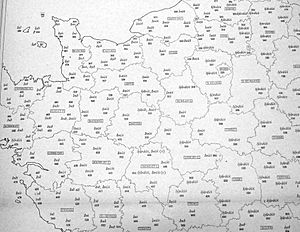Dialect continuum facts for kids
A dialect continuum is like a chain of different ways people speak a language across a large area. Imagine you're walking from one town to the next, and as you go, the way people talk changes just a little bit each time.
People in towns close to each other can usually understand each other easily. But if you travel far away, to a town at the other end of the chain, the way they speak might be so different that you can't understand them at all! It's like a gradual change, where there's no clear line where one dialect stops and another begins.
Contents
What is a Dialect Continuum?
A dialect continuum happens when a language slowly changes its sounds, words, and grammar as you move from one place to another. Think of it like colors blending into each other. Red might slowly become orange, then yellow, without a sharp break.
How Does it Work?
- Gradual Changes: The differences between how people speak are small between neighboring towns.
- Mutual Understanding: People living close to each other can usually understand each other.
- Distance Matters: The farther apart two places are, the harder it is for people from those places to understand each other. This is because the small changes add up over distance.
Why Do Dialect Continuums Form?
Dialect continuums often form because of how people interact over long periods.
- Limited Travel: In the past, people didn't travel far from their homes very often. This meant that language changes spread slowly from one village to the next.
- Neighborly Influence: Each village would pick up small language habits from its closest neighbors.
- Natural Evolution: All languages naturally change over time. When these changes happen slowly across a region, a continuum can form.
Examples of Dialect Continuums
Many languages around the world have or used to have dialect continuums.
Romance Languages
The Romance languages, like Spanish, French, Italian, and Portuguese, are a great example. They all came from Latin, the language spoken by the ancient Romans.
- If you travel across parts of Spain, France, and Italy, you might notice the language changing gradually.
- Someone from eastern Spain might understand someone from southern France better than someone from northern Italy.
- While Spanish and Italian are now considered separate languages, they were once part of a larger continuum that stretched across Europe.
German Dialects
In Germany, there's a famous dialect continuum called the "High German and Low German" continuum.
- In the north, people speak Low German dialects, which are quite different from the High German spoken in the south.
- However, if you move step-by-step from north to south, you'll find many dialects in between that connect them.
Arabic Dialects
The many different ways Arabic is spoken across North Africa and the Middle East also form a continuum.
- A person from Morocco might find it hard to understand someone from Iraq.
- But people in neighboring countries, like Algeria and Tunisia, can often understand each other well.
Why Are They Important?
Understanding dialect continuums helps us learn about:
- Language History: They show us how languages evolve and spread over time.
- Cultural Connections: They highlight the connections between different regions and their people.
- Defining Languages: They make us think about what makes a "language" different from a "dialect." Sometimes, the line is blurry!
Images for kids
See also
 In Spanish: Continuo dialectal para niños
In Spanish: Continuo dialectal para niños



